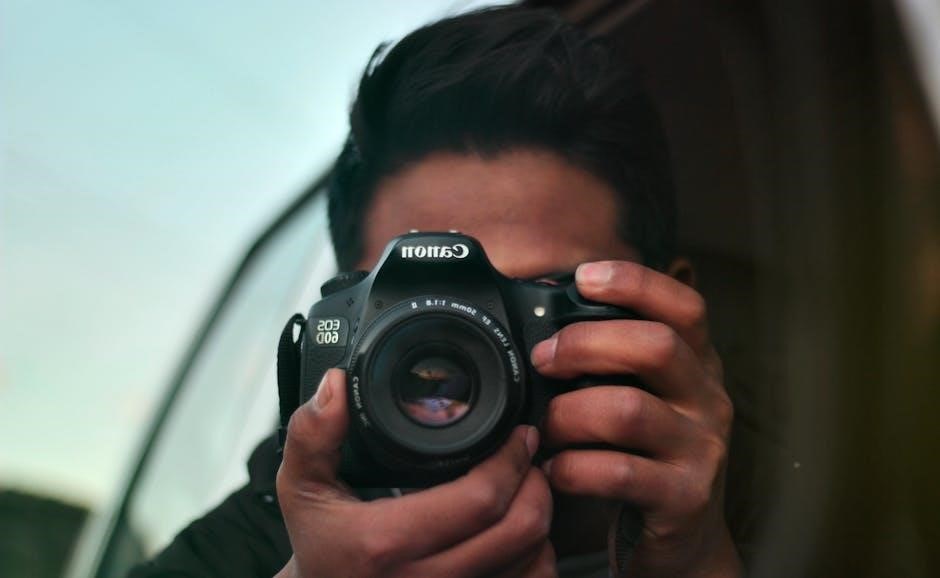The Canon AE-1 Program, introduced in 1981, is an advanced 35mm film SLR camera that combines automatic and manual controls, making it versatile for photographers of all levels.
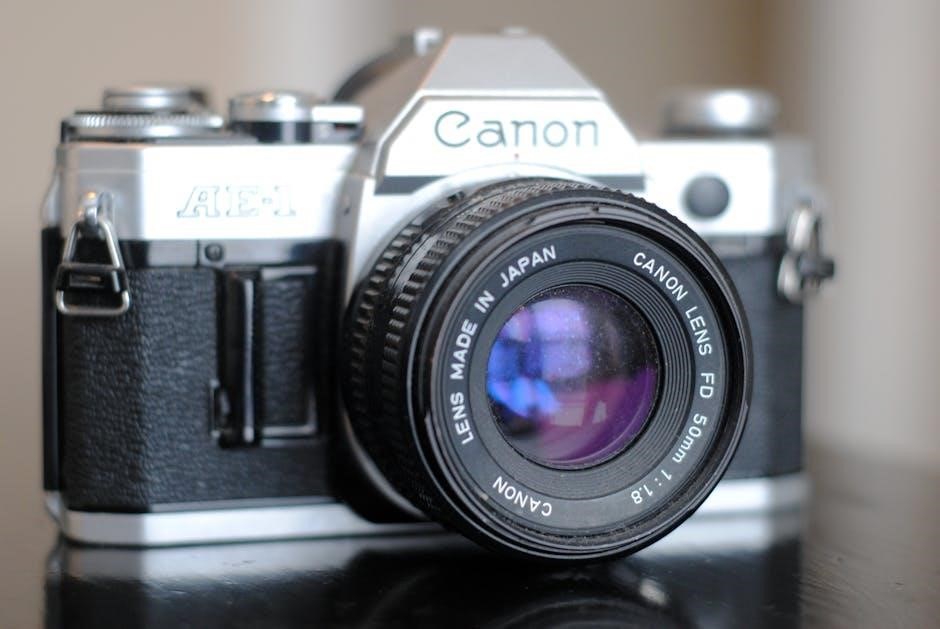
Key Features of the Canon AE-1 Program
The Canon AE-1 Program features Program Mode, Shutter Priority, Manual Mode, compatibility with Canon FD lenses, built-in flash, and a flash sync speed of 1/60s.
2.1. Program Mode
The Program Mode on the Canon AE-1 Program automatically adjusts both aperture and shutter speed for optimal exposure, offering ease of use while maintaining high image quality. Designed for simplicity, it allows photographers to focus on composition without manual adjustments. This mode is particularly beneficial for beginners and professionals alike, providing quick and reliable results. The camera’s microprocessor ensures balanced settings, making it ideal for various lighting conditions. While in Program Mode, the camera prioritizes ease of use, enabling users to capture sharp images effortlessly. This feature is a cornerstone of the AE-1 Program’s versatility and user-friendly design, making it a standout in film photography.
2.2. Shutter Priority and Manual Modes
The Canon AE-1 Program offers Shutter Priority and Manual Modes for advanced control. In Shutter Priority, users set the shutter speed, and the camera automatically adjusts the aperture for proper exposure. This mode is ideal for capturing motion or freezing moments. Manual Mode provides full control over both aperture and shutter speed, allowing photographers to fine-tune settings for creative results. These modes cater to professionals and enthusiasts who prefer hands-on control. The AE-1 Program’s design ensures ease of use, even in manual settings, making it a versatile tool for photographers seeking precision and artistic expression. These modes highlight the camera’s adaptability to various shooting scenarios and lighting conditions.
2.3. Lens Compatibility (Canon FD Lenses)
The Canon AE-1 Program is compatible with Canon FD lenses, offering a wide range of options for photographers. These lenses feature an “A” mode, enabling the camera to control the aperture automatically, enhancing functionality. With a variety of focal lengths available, from wide-angle to telephoto, FD lenses provide versatility for diverse shooting needs. The camera’s ability to work seamlessly with FD lenses ensures high-quality images and precise control over composition. Additionally, the manual focusing feature of these lenses allows for precise adjustments, catering to photographers who value tactile control and creative precision. This compatibility makes the AE-1 Program a flexible and powerful tool for capturing a wide range of photographic styles.
2.4. Built-in Flash and Flash Sync Speed
The Canon AE-1 Program does not feature a built-in flash but supports external flash units for additional lighting needs. The camera’s flash sync speed is set at 1/60th of a second, ensuring proper synchronization with compatible flash devices. When using a manual flash, photographers must set the shutter dial to 1/60s to achieve accurate exposure. This feature enhances the camera’s versatility, allowing for better control in low-light conditions while maintaining the integrity of the image. The lack of a built-in flash is offset by the ease of integrating external units, making the AE-1 Program adaptable for various lighting scenarios.
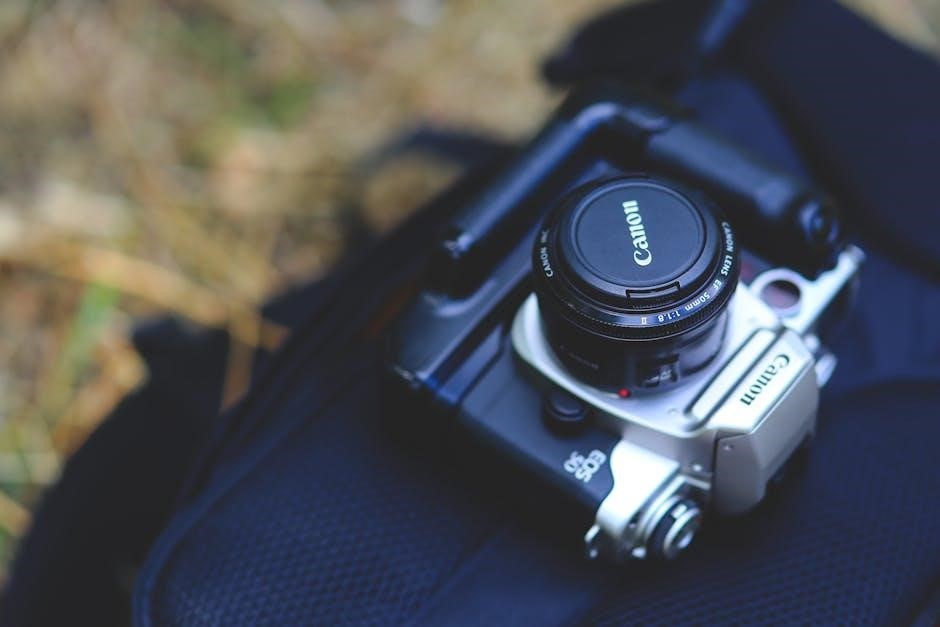
The Canon AE-1 Program Manual
The Canon AE-1 Program manual provides detailed guidance on camera operation, features, and troubleshooting, ensuring users can fully utilize its capabilities. It is available online.
3.1. Overview of the Manual
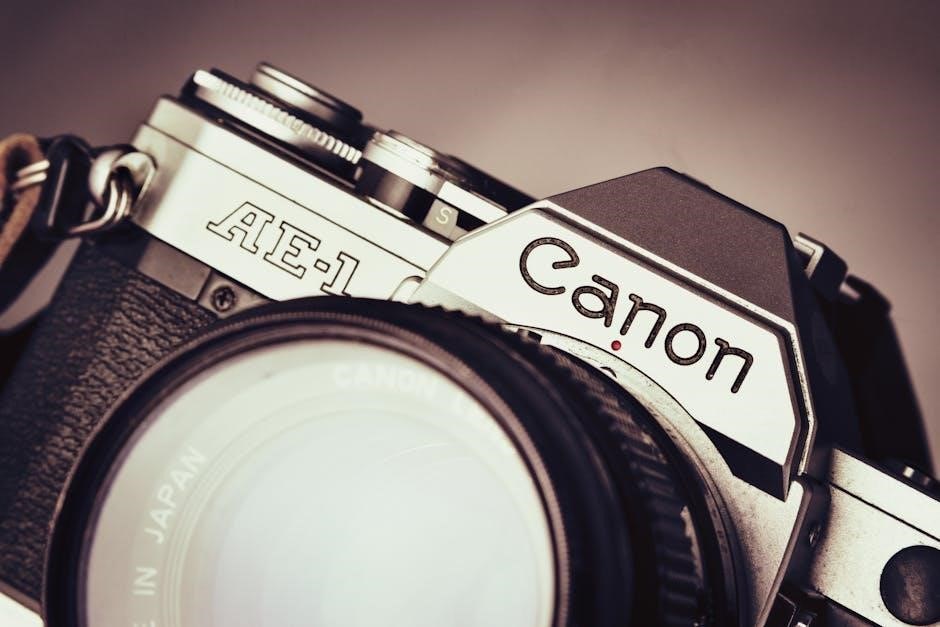
The Canon AE-1 Program manual is a comprehensive guide designed to help users master the camera’s features. It covers everything from basic controls to advanced shooting techniques.
Available online, the manual is organized into clear sections, making it easy to navigate. It includes detailed explanations of modes, settings, and troubleshooting tips, catering to both beginners and professionals.
With a focus on practical application, the manual ensures photographers can fully utilize the camera’s capabilities, from automatic program mode to manual adjustments, enhancing their creative control and shooting experience.
3.2. Understanding the Specifications
The Canon AE-1 Program manual provides detailed specifications, highlighting the camera’s technical capabilities. It features a 35mm film format, manual and automatic shooting modes, and compatibility with Canon FD lenses. The camera supports shutter speeds from 1/1000th of a second to 12 seconds, with a flash sync speed of 1/60s. The manual outlines the camera’s dimensions, weight, and battery requirements, ensuring users understand its operational needs. These specifications emphasize the camera’s versatility and ease of use, catering to both amateur and professional photographers. The manual ensures users can fully leverage the camera’s features for optimal performance.

How to Use the Program Mode
Program Mode automatically adjusts aperture and shutter speed for optimal exposure, allowing photographers to focus on composition while the camera handles technical settings seamlessly.
4.1. Automatic Exposure Control
The Canon AE-1 Program’s automatic exposure control is a standout feature, allowing photographers to achieve precise exposures without manual adjustments. In Program Mode, the camera’s microprocessor automatically adjusts both the aperture and shutter speed to ensure optimal exposure for various lighting conditions. This feature is particularly useful for beginners or those who prefer a hands-off approach. The system relies on the camera’s built-in light meter, which measures the available light and selects the best combination of aperture and shutter speed. This automation ensures that images are well-exposed, even in challenging lighting scenarios, making the AE-1 Program a versatile tool for photographers of all skill levels.
4.2. Adjusting Settings in Program Mode
While the Canon AE-1 Program’s automatic exposure control simplifies photography, users can still make adjustments to refine their shots. Exposure compensation is achievable by adjusting the aperture ring, allowing for ±2 stops of adjustment. Additionally, the camera’s flash sync speed can be set manually at 1/60s for external flash use. Photographers can also override the program mode by selecting a specific aperture or shutter speed, enabling creative control. These adjustments ensure flexibility, catering to both novice and experienced photographers seeking to tailor their images without leaving the convenience of Program Mode.
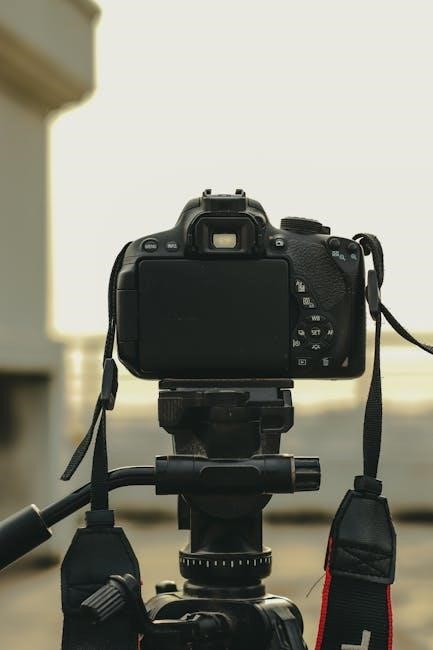
Shooting Modes
The Canon AE-1 Program offers three primary shooting modes: Program Mode, Shutter Priority, and Manual Mode, catering to both automatic and manual photography preferences with ease and versatility.
5.1. Shutter Priority Mode
In Shutter Priority Mode, photographers can manually set the shutter speed, allowing the camera to automatically adjust the aperture for optimal exposure. This mode is ideal for capturing motion, as it enables control over freezing fast-moving subjects or creating motion blur. Users can select shutter speeds ranging from 1/1000th of a second to 1 second, giving precise control over the image’s dynamic effects. The AE-1 Program’s microprocessor ensures the aperture adjusts accurately, maintaining proper exposure. This mode is particularly useful for action photography, low-light conditions, and creative effects, offering a balance between manual control and automatic functionality.
5.2. Manual Mode
Manual Mode offers full creative control, allowing photographers to independently adjust both aperture and shutter speed. This mode is ideal for experienced users who prefer precise control over their settings. The aperture is set using the lens aperture ring, while the shutter speed is adjusted via the camera’s dial. The AE-1 Program’s built-in light meter provides guidance, but the user has complete freedom to override suggested settings. This mode is particularly useful in complex lighting conditions or for achieving specific artistic effects, such as intentional overexposure or underexposure. Manual Mode is a powerful tool for photographers who want absolute command over their camera settings.

Maintenance and Troubleshooting
Regularly clean the camera and lenses with a soft cloth to prevent dust buildup. Check battery health and ensure proper installation for optimal performance.
6.1. Cleaning the Camera
Regular cleaning ensures optimal performance and longevity of the Canon AE-1 Program. Use a soft, dry cloth to wipe the camera body and external components. For the lens, employ a microfiber cloth and gentle circular motions to remove smudges. Avoid harsh chemicals or abrasive materials that could damage surfaces. The mirror and viewfinder should be cleaned carefully with a bulb blower to remove dust. For stubborn spots, a slightly dampened cloth may be used, but avoid moisture exposure to electrical components. Clean the camera regularly to maintain image quality and prevent dust buildup; Proper maintenance ensures your AE-1 Program remains reliable for years. Always handle the camera with care to preserve its functionality and aesthetic condition. Regular cleaning is essential for maintaining the camera’s performance and extending its lifespan. By following these steps, you can keep your Canon AE-1 Program in excellent working order.
6.2. Common Issues and Solutions
The Canon AE-1 Program is durable, but occasional issues arise. A common problem is inaccurate metering, often due to battery weakness. Replace the batteries or check connections if this occurs. Another issue is jammed film advancement, which can be resolved by gently rewinding and reloading film. If the shutter fails to fire, ensure the camera is in manual mode and the shutter speed is set correctly. For faulty light meters, consult a professional. Regular maintenance, like cleaning the electrical contacts, can prevent many issues. Always handle the camera with care to avoid mechanical damage. Addressing these common problems promptly ensures uninterrupted photography sessions. Proper troubleshooting extends the camera’s lifespan and maintains its reliability. By identifying and resolving issues quickly, photographers can continue capturing high-quality images with ease. Regular checks and maintenance are key to preventing complications and ensuring optimal performance.
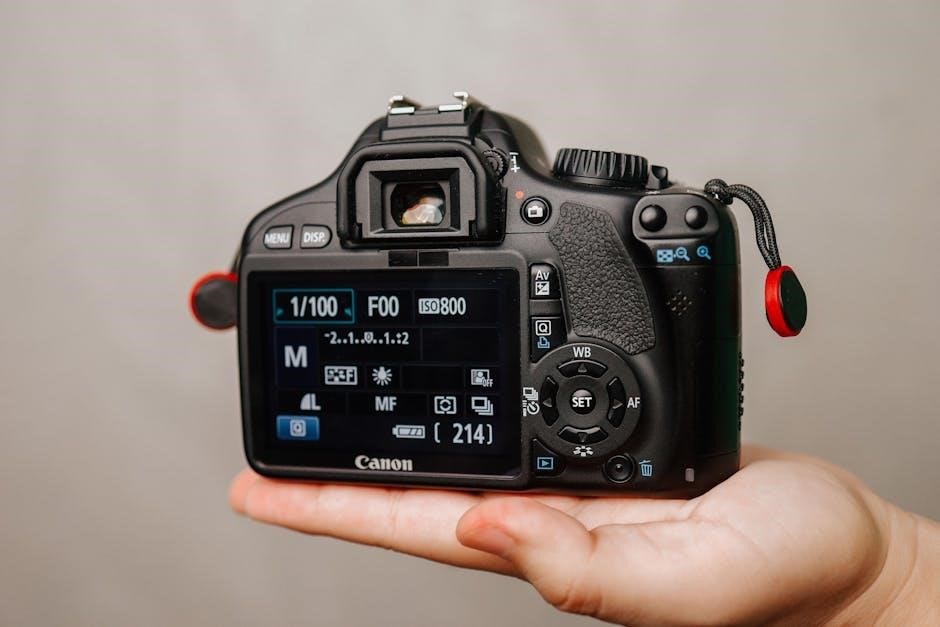
Accessories for the Canon AE-1 Program
The Canon AE-1 Program supports various accessories, enhancing functionality and convenience. These include additional FD lenses, powerful flash units, and practical items like camera bags and remote shutters.
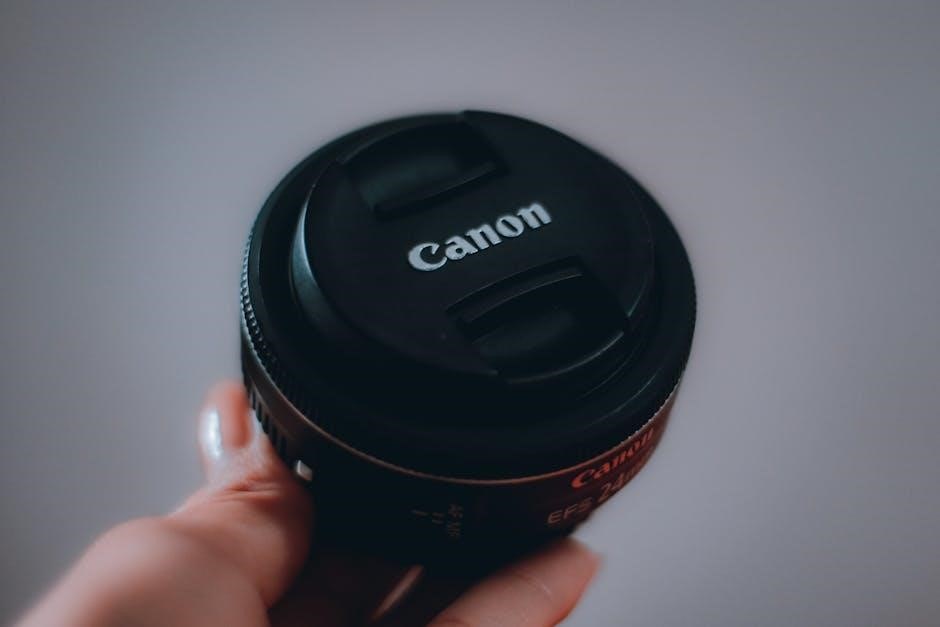
7.1. Lenses
The Canon AE-1 Program is compatible with a wide range of Canon FD lenses, offering exceptional optical quality and versatility. The FD series includes lenses from wide-angle to telephoto, catering to diverse shooting needs. The camera’s aperture-priority and program modes work seamlessly with these lenses, ensuring precise exposure control. Photographers can choose from lenses like the 50mm f/1.8, 28mm f/2.8, and 70-200mm zoom, each designed to deliver sharp images. Additionally, the FD mount allows for easy lens swapping, making it ideal for enthusiasts and professionals alike. This compatibility enhances the camera’s adaptability for various photography styles and scenarios, ensuring optimal performance across different focal lengths.
7.2. Flash Units
The Canon AE-1 Program supports various flash units, enhancing its versatility in low-light conditions. The camera features a built-in flash with a sync speed of 1/60s, ideal for everyday use. Photographers can also use external flash units, including Canon’s dedicated Speedlite models like the 199A and 277T, for more advanced lighting control. The AE-1 Program allows manual flash synchronization, giving users precise control over lighting setups. When using manual flash, the shutter speed should be set to 1/60s for optimal results. This compatibility ensures photographers can achieve professional-quality lighting, making the AE-1 Program a reliable choice for both indoor and outdoor photography needs.
7.3. Other Accessories
Beyond lenses and flash units, the Canon AE-1 Program supports a range of accessories to enhance functionality and user experience. The optional Motor Drive MA allows for continuous shooting at up to 4 frames per second, ideal for capturing fast-moving subjects. A Remote Switch is available for tripod-based photography, minimizing camera shake during long exposures. The AE-1 Program also accommodates interchangeable focusing screens, catering to specific shooting styles. Additionally, camera cases and straps provide protection and convenience. These accessories ensure the AE-1 Program can be adapted to various photographic needs, whether in studio or field settings, offering photographers flexibility and customization options to suit their preferences and professional demands.
The Canon AE-1 Program stands as a landmark camera in the history of photography, blending automation with manual control for unparalleled versatility. Introduced in 1981, it quickly became a favorite among both amateur and professional photographers due to its ease of use and advanced features. The Program mode, shutter priority, and manual options catered to diverse shooting styles, while its compatibility with Canon FD lenses and built-in flash capabilities expanded creative possibilities. Its durable design and intuitive interface made it a timeless tool for capturing high-quality images. Even today, the AE-1 Program remains a sought-after choice for film photography enthusiasts, embodying a perfect balance of innovation and tradition that continues to inspire photographers worldwide.
